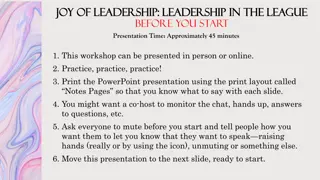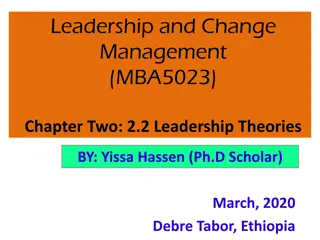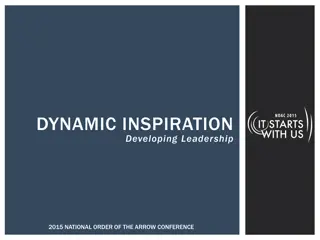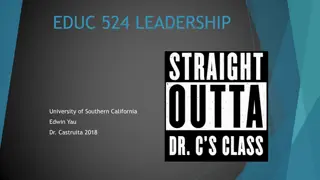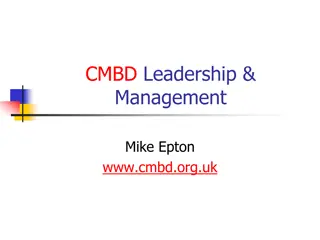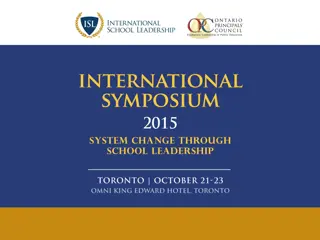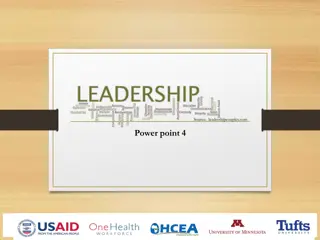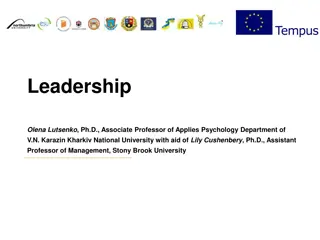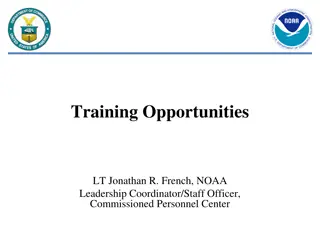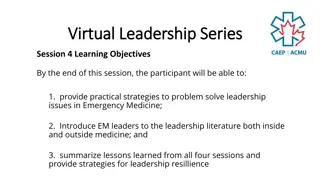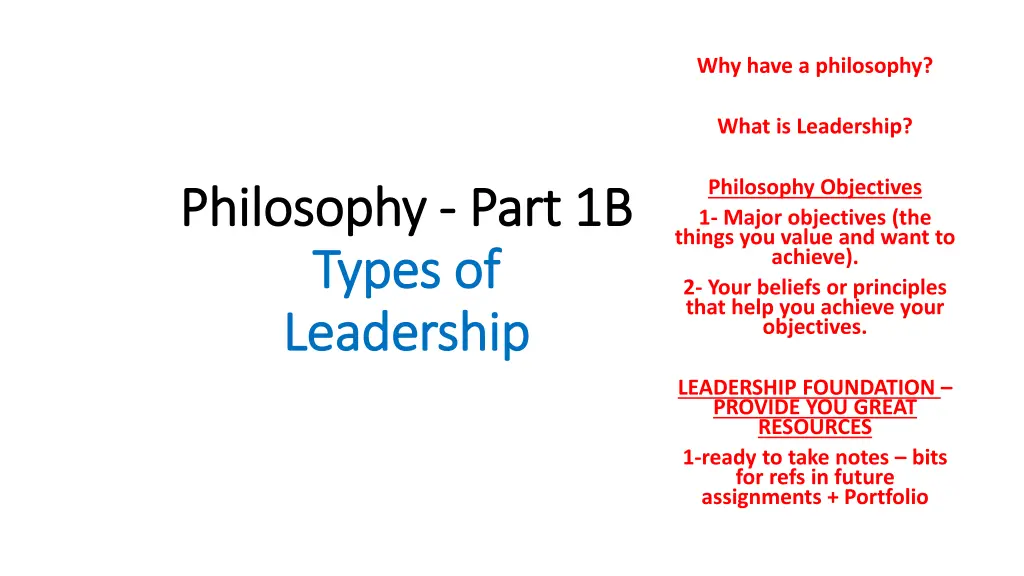
Leadership Philosophy: Objectives and Types
Explore the essence of leadership philosophy, its major objectives centered on values and principles, and delve into different types of leadership including transformational and leaders as teachers. Uncover the key elements that define effective leadership and how leaders can earn respect through trust and sound decision-making.
Download Presentation

Please find below an Image/Link to download the presentation.
The content on the website is provided AS IS for your information and personal use only. It may not be sold, licensed, or shared on other websites without obtaining consent from the author. If you encounter any issues during the download, it is possible that the publisher has removed the file from their server.
You are allowed to download the files provided on this website for personal or commercial use, subject to the condition that they are used lawfully. All files are the property of their respective owners.
The content on the website is provided AS IS for your information and personal use only. It may not be sold, licensed, or shared on other websites without obtaining consent from the author.
E N D
Presentation Transcript
Why have a philosophy? What is Leadership? Philosophy Objectives 1- Major objectives (the things you value and want to achieve). 2- Your beliefs or principles that help you achieve your objectives. Philosophy Philosophy - - Part 1B Types of Types of Leadership Leadership Part 1B LEADERSHIP FOUNDATION PROVIDE YOU GREAT RESOURCES 1-ready to take notes bits for refs in future assignments + Portfolio
By definition By definition Leadership = by definition must have followers (team or individual) Leaders provide vision / create clarity / foster hope by telling people that they believe in them / and of course - deliver results (success excellence) Leadership is first knowing how to chart a course, to give others direction by having a vision of what can be (team working toward a common goal)
Transformational Leadership Transformational Leadership Sauer, P. (2017, April). Effective Leadership in Sports. thesportdigest.com. Retrieved from http://thesportdigest.com/2017/04/effective-leadership-in-sports In comparison to the transactional model, transformational leadership is more than just meeting immediate needs. It is all about identifying the follower s potential motivations and creating a common and shared objective. Transformational leadership underscores the importance of vision, intellectual stimulation, and individualized consideration in leadership. Style of leadership in which the leader identifies the needed change, creates a vision to guide the change through inspiration, and executes the change with the commitment of the members of the group.
Leaders as Teachers Leaders as Teachers Are Leaders Teachers? Are followers Students? Can we be both? Chuck Long quote (anyone know who he is)? good start chance for a good finish
My Leaders My Leaders *I am the follower *I am the follower Sylvie Lee & Nella Bee They RULE me and I love it
Leadership Leadership Leadership is not so much leading as having the people accept you (want you to lead them) You know how you do that? 1. You ve got to win the hearts of the people you lead (build TRUST) 2. The personality of the individual has to do it *Agree - disagree? #1 Value? Other Values? *SEE Great Quotes https://www.keepinspiring.me/vince-lombardi-quotes/
How Do Leaders Earn Respect? How Do Leaders Earn Respect? By making sound decisions, admitting their mistakes and putting what is best for the team ahead of their personal agenda. TRUST makes leadership possible Definition Merriam Webster Dictionary: 1-assured reliance on the character, strength, or truth of someone or something 2-a basis of reliance, faith or hope 3-confident hope
What Leaders Do What Leaders Do Provide direction - goals - VISION Create a TEAM CULTURE Instill VALUES Inspire TRUST MOTIVATE people to pursue the goals of the team CONFRONT and resolve CONFLICT COMMUNICATE effectively and consistently Vivian Stringer Coaching Women & Leadership (2m) Rutgers University Hall of Famer ex Hawkeye http://www.youtube.com/watch?v=9QPkx6nw6C0
Team Culture Defined Team Culture Defined Team culture defined = the way things are done on the team it is the social architecture that nurtures the team psyche. A healthy team culture creates a climate for success Team culture is concerned with how rewards are given, who communicates with whom about what, practice procedures, game protocols, acceptable reactions toward winning and losing, dress codes, and so on (other examples from experiences?)
Components of team Culture Components of team Culture 1- Team tradition 2- Basic operating procedures 3 - Management information 4 - Nature of the sport 5 - Power, influence, status structure of team 6 - Leadership style of the coach
Leadership Theory Leadership Theory - - Resources Resources James Kouzes and Barry Posner, in their book The Leadership Challenge, present five basic practices of all exemplary leaders: Inspiring a shared vision Challenging the process Enabling others to act Modeling the way Encouraging the heart Kouzes and Posner conclude that leadership is not a mystical quality, but a pattern of behavior that anyone can use to create extraordinary results. However, when it comes to how the practice is put into action, a tremendous amount of variance is possible, based on the situation. The specifics of how these leadership practices are conveyed and what causes the variances by situation was explored by Dr. Paul Hersey from the Center for Leadership Studies. His research and current work emphasizes that leadership is situational and varies based on the readiness of the team and its members. *Outward bound outdoor adventure theory Coach K Leading with Heart Video (2:06 min) http://www.youtube.com/watch?v=Phny1h4AZ0Y
Situational Leadership Situational Leadership - - Styles Styles Dr. Hersey's main principle, Situational Leadership, breaks the leadership practice into three widely accepted leadership styles 1 - autocratic / commander / director / general *leader directs the team - controlling style - older military mindset 2 - Participative / democratic / cooperative / transformative *leader guides the team - dynamic experience in which you influence the team, and the team influences you. 3 - laissez-faire / submissive / abdicate / baby-sitter *leader makes as few decisions as possible - lacking accountability.
New Wave New Wave Hybrid Coach Hybrid Coach Combo of all 3 = you transform the power of leadership to the team - and they, in return transform that power back to you as the Designated Leader *(allows for emergent leader from the team to develop) EVERYONE is a leader - everyone has power. Leadership Photo Pat Summitt (top combo) Demands Much Enables and Empowers *Video 1 youtube greatest coaches sportscentury (old school or hybrid)? http://www.youtube.com/watch?v=gxwWARmyVfI
Coaching style clinic Coaching style clinic Brainstorm name examples of the different coaching styles *real or not movies are ok + fun List strengths and weakness of each coaching model-style List what we can learn from each Write your Definition of Leadership *use with phil assignment you research and provide an coaching role model (ind selection)


